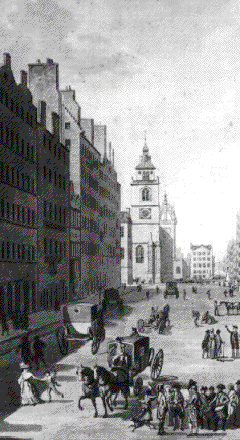Highways in Edinburgh
First half of the 18th Century

- High Street in Edinburgh
- [click on the picture to enlarge it]
In the first half of the 18th century, Scottish towns were not pleasant sights for foreign eyes. The filth of certain alleys, the decrepit fronts of numerous residences, the nauseating smells given off from rubbish strewn over the ground, filled them with disgust. Even Edinburgh, renowned for the beauty of its buildings and its High Street, was the object of sharp criticism from certain visitors, who were so offended by such dirty streets. The Englishman Joseph Taylor lambasted this in his book A Journey to Edenborough in Scotland in 1705 (Edinburgh, 1705; rpt. Edinburgh, 1903):
Every street shows the nastiness of the Inhabitants, the excrements lye in heaps.
...In a Morning the Scent was so offensive, that we were forc’t to hold our Noses as we past the Streets, and take care where we trod for fear of disobliging our shoes, and to walk in the middle at night, for fear of an accident on our heads. (134)
What Joseph Taylor feared to receive on the head while walking in the streets of Edinburgh at night or in the early morning was the contents of a chamber-pot emptied unceremoniously from the window of an honest citizen of this town, after having nevertheless taken care to cry out gardiloo.
“wynd”= a narrow lane or street
“close”= a narrow alley
(Chambers Scots Dictionary)
“gardy loo” : “garde à leau”: warning cry about dirty water thrown from windows or to the streets
(Chamber’s Scots Dictionary)
If a late-night walker did not want to have his wig or evening dress dirtied by excrement tipped out from the sixth floor of a building, he also had to warn lodgers out loud that he was passing under their windows, for after ten o’clock, ’it is Fortune favours you, observed James Ray, author of A Complete History of the Rebellion (York, 1749), if a chamber-pot with excrements is not thrown on your head, if you are walking in the streets; it is then diverting to strangers, to hear all passers-by cry out with a loud voice, sufficient to reach the tops of the houses, which are generally six or seven stories high in the Front of the High Street - “Hoad yare Hand ,” i.e. hold your hand, and means do not throw till I am passt ’(288).
The inhabitants also threw out of the windows, from 10 o’clock at night, their waste water and garbage. The refuse remained in the street all night until one or two garbage collectors came to collect it around seven o’clock in the morning. On Sunday, work being considered a mortal sin, even by garbage collectors, the rubbish was not taken away. It is not difficult to imagine the state of the streets on Sunday evenings and the odours given off by the piles of filth. The anonymous author of a hand-written letter “Letter Describing a Tour in Scotland c. 1700”, dated 23rd September c.1700, did not hesitate to describe Edinburgh as ’the most stinking city in the world’ (National Library of Scotland MS. 1003,fol. 126).
Second half of the 18th century
Though Edinburgh in the early and mid 18th century had been much criticised by travellers for its uncomfortable inns, its scarce entertainments, its stinking streets and its unhealthy houses, from 1780 onwards it became one of the most admired capitals of Europe. Blame gave way to praise when the New Town, with its harmonious colours and architectural forms, rose from the ground on the other side of Loch Nor, and renovation work was undertaken in the Old Town. While the New Town was being built, “Auld Reekie”, now inhabited by the less affluent part of the population, was not however neglected by the authorities, and was undergoing a renewal process.
The health and social improvement measures decided by the city fathers included renovating some of the decayed parts of the town such as Grassmarket and Cowgate, restoring numerous cracked and shaky houses in High Street and Canongate, and thus conferring “an air of neatness and elegance” to the old Edinburgh so dear to the heart of all Scotsmen, according to John Lettice’s phrase in Letters on a Tour through various parts of Scotland in the Year 1792 (London, 1794), 520.
“Auld Reekie” (Scots “Auld”= “old”,and “Reekie”= “smoky”), the nickname of Edinburgh, due to the smoke from the chimneys which blackened the walls with soot.

